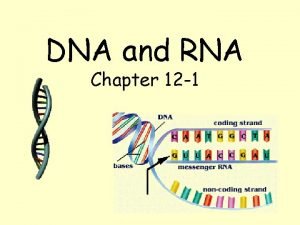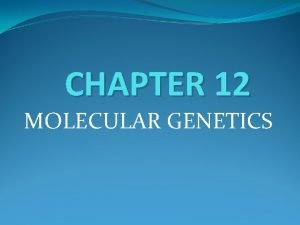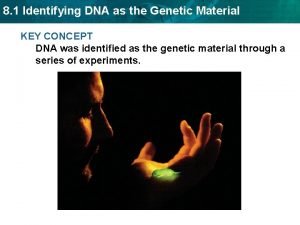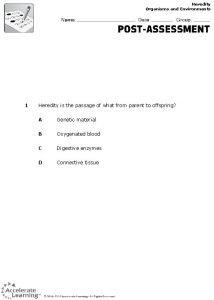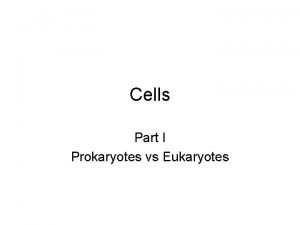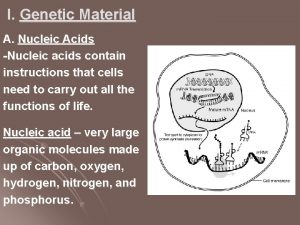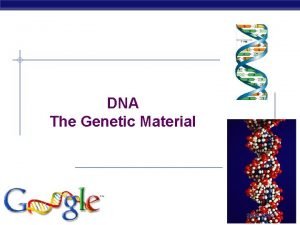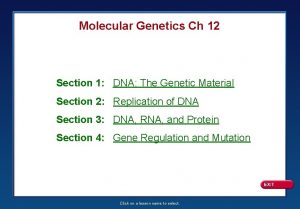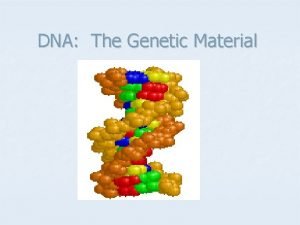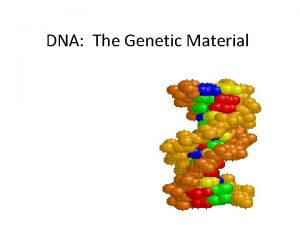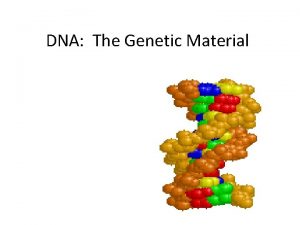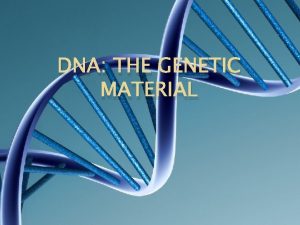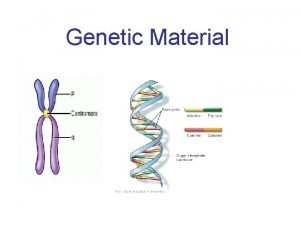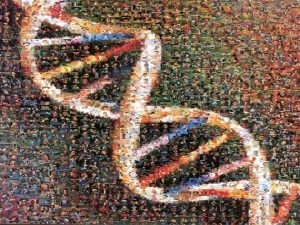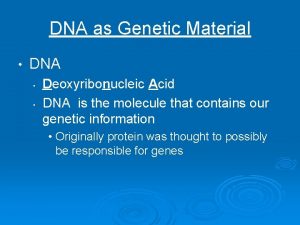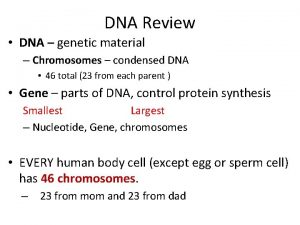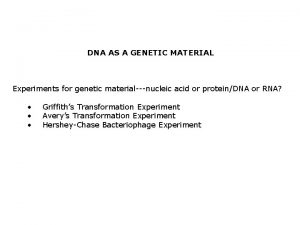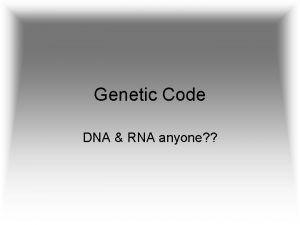DNA as genetic material Structure of DNA DNA




















- Slides: 20

- DNA as genetic material - Structure of DNA - DNA replication Sections 8. 1, 8. 2, and 8. 3

What is this stuff?

DNA!!! ▪ Deoxyribonucleic Acid ▪ Consists of 4 bases – Adenine – Thymine – Guanine – Cytosine

Frederick Griffith ▪ Did experiments with 2 different types of pneumonia ▪ Smooth vs. rough – Smooth covered in with sugars – Rough does not have this covering

His experiment

Why did this happen? ▪ Some sort of material must have transferred between the live R and the heat killed S – Did not know it was DNA just yet ▪ Called the mystery material “transforming principle”

Oswald Avery ▪ Worked on extending Griffiths work – 10 years!!! ▪ Combined lived R bacteria with extract from S bacteria – Were able to directly observe the change of R bacteria into S

Avery’s experiments ▪ Qualitative tests – Chemical tests showed there was actually NO proteins present. Only DNA ▪ Chemical analysis – These show the amounts or proportions of elements found in DNA. Proteins hardly contain phosphorus ▪ Enzyme tests – Enzymes known to break down proteins and RNA did nothing to stop the transformation. Only enzymes that broke down DNA stopped the process

Hershey and Chase ▪ Confirmed DNA as genetic material in 1952 ▪ Studied viruses that infected bacteria – Bacteriophages ▪ Take over a bacterial cell to make more bacteriophages – Very simple things ▪ A small amount of DNA covered by a protein coat

Bacteriophages!!!

How do they work?

Their experiments ▪ Experiment 1 – Tagged radioactive sulfur atoms on phage’s protein molecules – Let phages infect bacteria – Studied bacteria after they were infected – Found very little radioactivity present in bacteria ▪ Proteins WERE NOT passed to the bacteria from the bacteriophages

Their experiments ▪ Experiment 2 – Tagged phosphorus molecules in the phage’s DNA with radioactivity – Let phages infect bacteria – Studied bacteria after they were infected – Found A LOT of radioactivity within the bacteria ▪ DNA was passed to bacteria. More phages are made within the bacteria. ▪ Increased phages = increased radioactive tags

DNA structure ▪ Consists of 4 bases or nucleotides ▪ 2 parts to the “backbone” – 1 phosphate group – Ring-ring shaped sugar ▪ deoxyribose

Base pairing rules ▪ Adenine always pairs with Thymine – Double ring with double ring ▪ Guanine always pairs with Cytosine – Single ring with single ring ▪ A=T and C=G – Chargaff’s rule

Base pairing practice ▪ GTA ▪ CTTGAC ▪ GATTACA ▪ TTGGACCGGAT

Watson and Crick ▪ Got credit for the shape of DNA – Used an image they were not supposed to have – Stolen from Rosalind Franklin ▪ They waited until she died before submitting their results to be published ▪ Ended up winning the Nobel Prize ▪ She got no posthumous credit for “their” work


Split into 2 groups

 Chapter 12 section 1 dna the genetic material
Chapter 12 section 1 dna the genetic material Chapter 12 section 1 molecular genetics answer key
Chapter 12 section 1 molecular genetics answer key Section 12-1 dna
Section 12-1 dna Chapter 12 dna and rna section 12-1
Chapter 12 dna and rna section 12-1 Chapter 12 section 1 dna the genetic material
Chapter 12 section 1 dna the genetic material Section 1 identifying dna as the genetic material
Section 1 identifying dna as the genetic material Genetic drift vs flow
Genetic drift vs flow Genetic programming vs genetic algorithm
Genetic programming vs genetic algorithm Genetic programming vs genetic algorithm
Genetic programming vs genetic algorithm Genetic drift
Genetic drift What is the difference between genetic drift and gene flow
What is the difference between genetic drift and gene flow Heredity is best described as the -
Heredity is best described as the - Chapter 3 cells and tissues
Chapter 3 cells and tissues Which part of the cell contains genetic material
Which part of the cell contains genetic material Nucleic acid made up of
Nucleic acid made up of Genetic material
Genetic material Chapter 12 section 1 the genetic material
Chapter 12 section 1 the genetic material Controlled radius
Controlled radius Material usage variance = material mix variance +
Material usage variance = material mix variance + Ethnocentrism examples
Ethnocentrism examples Whats cultural lag
Whats cultural lag



